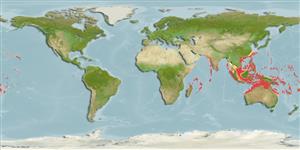Common names from other countries
Environment: milieu / climate zone / depth range / distribution range
экология
морской ассоциированный с рифами; немигрирующий; пределы глубины 10 - 120 m (Ref. 9710), usually 25 - 120 m (Ref. 9710). Tropical; 28°N - 24°S, 46°E - 156°W (Ref. 5222)
Indo-Pacific: scattered insular localities from the Comoros to the Line Islands. Unknown from the Red Sea, coast of East Africa, Sri Lanka, Australia, New Guinea, and the larger islands of Indonesia.
Length at first maturity / Size / Вес / Возраст
Maturity: Lm ?, range 25 - ? cm
Max length : 43.0 cm TL самец/пол неопределен; (Ref. 5222)
колючие лучи спинного плавника (общее число) : 9; членистые (мягкие) лучи спинного плавника (общее число) : 14 - 16; колючие лучи анального плавника: 3; членистые (мягкие) лучи анального плавника: 8 - 9. Characterized by yellow to greenish yellow color; head, body and fins with bright blue stripes; body scales ctenoid, including abdomen; pelvic fins, 1.5-1.9 in head length; greatest depth of body 2.7-3.1 in SL; truncate caudal fin to slightly emarginate (Ref. 90102); eye diameter subequal to interorbital width and about twice the depth of the preorbital; rounded preopercle, finely serrate, lower edge with 1-3 broad serrae; subopercle and interopercle finely serrate; maxilla reaches approximately to vertical at rear edge of eye; pectoral fins subequal to pelvic fins, pectoral fin length contained 1.5-1.9 times in HL (Ref. 089707)
Sporadic distribution (Ref. 48635). Occurs only at oceanic islands. Inhabits clear waters of steep drop-offs; rarely seen in less than 30 m. It has been taken in depths of 120 m and may occur deeper. Also found in caves and crevices. Often swims upside-down against the roofs of caves or archways (Ref. 37816). Feeds on fishes and crustaceans (Ref. 89972). Solitary (Ref 90102).
Life cycle and mating behavior
Maturities | размножение | Spawnings | Egg(s) | Fecundities | личинки
Heemstra, P.C. and J.E. Randall, 1993. FAO Species Catalogue. Vol. 16. Groupers of the world (family Serranidae, subfamily Epinephelinae). An annotated and illustrated catalogue of the grouper, rockcod, hind, coral grouper and lyretail species known to date. Rome: FAO. FAO Fish. Synop. 125(16):382 p. (Ref. 5222)
Статус Красного Списка МСОП (Ref. 130435)
CITES (Ref. 128078)
Not Evaluated
Угроза для людей
Harmless
Использование человеком
рыболовство: рыболовство как средство для существования; объект спортивного рыболовства: да
дополнительная информация
инструменты
Специальные отчеты
Скачать в формате XML
ресурсы в Интернет
Estimates based on models
Preferred temperature (Ref.
115969): 20.7 - 28.2, mean 26.5 (based on 670 cells).
Phylogenetic diversity index (Ref.
82804): PD
50 = 0.5000 [Uniqueness, from 0.5 = low to 2.0 = high].
Bayesian length-weight: a=0.01259 (0.00590 - 0.02687), b=3.04 (2.87 - 3.21), in cm Total Length, based on LWR estimates for this Genus-body shape (Ref.
93245).
Trophic level (Ref.
69278): 4.2 ±0.7 se; based on size and trophs of closest relatives
устойчивость к внешним воздействиям (Ref.
120179): средний (среднего размера), минимальное время удвоения популяции 1.4-4.4 года (Preliminary K or Fecundity.).
Fishing Vulnerability (Ref.
59153): Low to moderate vulnerability (33 of 100).
